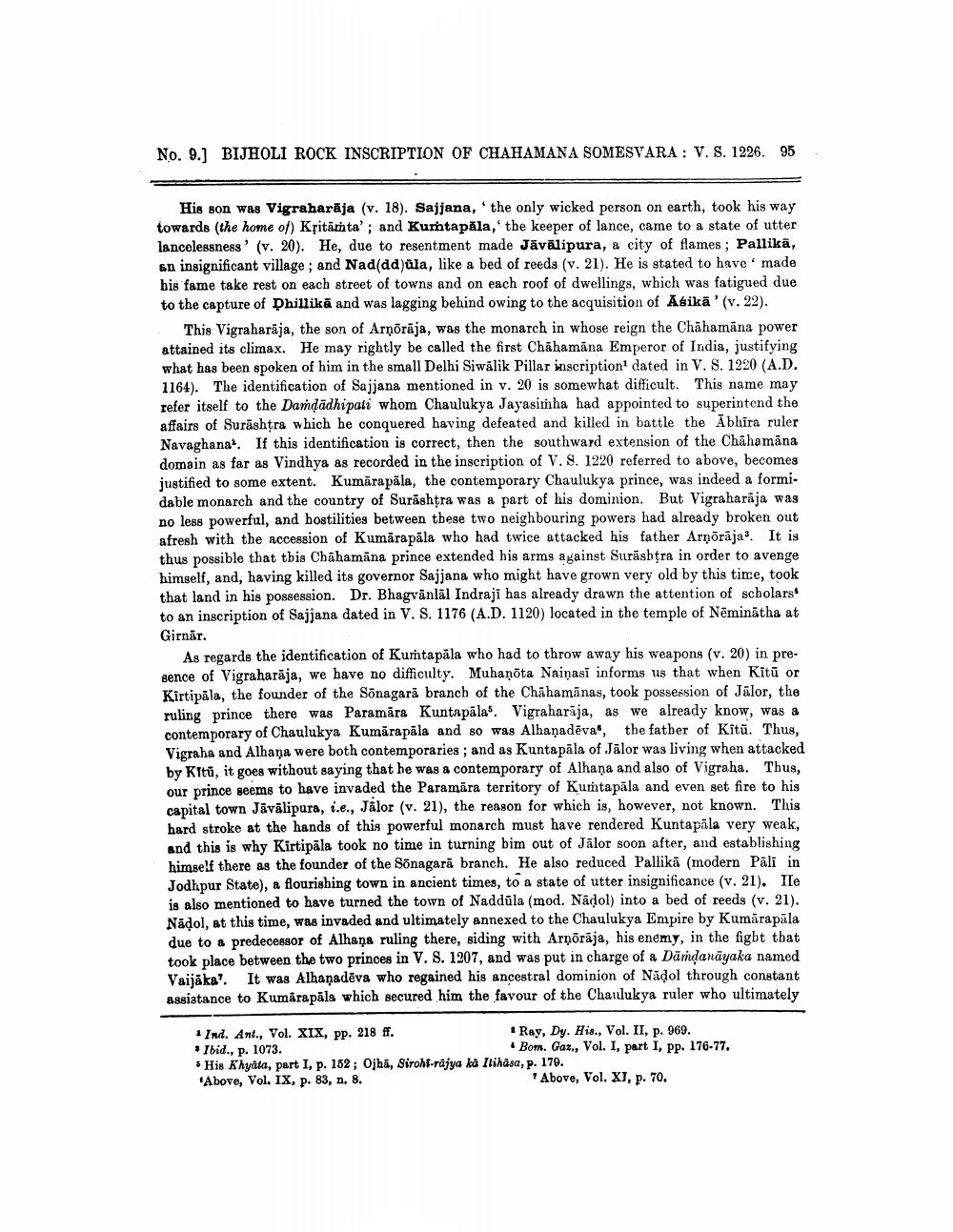________________
No. 9.] BIJHOLI ROCK INSCRIPTION OF CHAHAMANA SOMESVARA: V. S. 1226. 95
4
His son was Vigraharaja (v. 18). Sajjana, the only wicked person on earth, took his way towards (the home of) Kritamta'; and Kumtapala, the keeper of lance, came to a state of utter lancelessness (v. 20). He, due to resentment made Jävälipura, a city of flames; Pallikā, an insignificant village; and Nad(dd)üla, like a bed of reeds (v. 21). He is stated to have made his fame take rest on each street of towns and on each roof of dwellings, which was fatigued due to the capture of Dhillika and was lagging behind owing to the acquisition of Asika' (v. 22).
2
This Vigraharaja, the son of Arņōrāja, was the monarch in whose reign the Chahamana power attained its climax. He may rightly be called the first Chahamana Emperor of India, justifying what has been spoken of him in the small Delhi Siwälik Pillar inscription' dated in V. S. 1220 (A.D. 1164). The identification of Sajjana mentioned in v. 20 is somewhat difficult. This name may refer itself to the Damḍadhipati whom Chaulukya Jayasimha had appointed to superintend the affairs of Surashtra which he conquered having defeated and killed in battle the Abhira ruler Navaghana. If this identification is correct, then the southward extension of the Chahamana domain as far as Vindhya as recorded in the inscription of V. S. 1220 referred to above, becomes justified to some extent. Kumarapala, the contemporary Chaulukya prince, was indeed a formidable monarch and the country of Surashtra was a part of his dominion. But Vigraharaja was no less powerful, and hostilities between these two neighbouring powers had already broken out afresh with the accession of Kumarapala who had twice attacked his father Arņōrāja3. It is thus possible that this Chahamana prince extended his arms against Surashtra in order to avenge himself, and, having killed its governor Sajjana who might have grown very old by this time, took that land in his possession. Dr. Bhagvanlal Indraji has already drawn the attention of scholars to an inscription of Sajjana dated in V. S. 1176 (A.D. 1120) located in the temple of Neminatha at Girnär.
As regards the identification of Kumtapāla who had to throw away his weapons (v. 20) in presence of Vigraharaja, we have no difficulty. Muhaņota Naiņasi informs us that when Kitu or Kirtipāla, the founder of the Sonagara branch of the Chahamānas, took possession of Jalor, the ruling prince there was Paramara Kuntapala. Vigraharaja, as we already know, was a contemporary of Chaulukya Kumarapala and so was Alhaṇadeva, the father of Kitu. Thus, Vigraha and Albana were both contemporaries; and as Kuntapala of Jalor was living when attacked by Kitů, it goes without saying that he was a contemporary of Alhana and also of Vigraha. Thus, our prince seems to have invaded the Paramāra territory of Kumtapala and even set fire to his capital town Javälipura, i.e., Jalor (v. 21), the reason for which is, however, not known. This hard stroke at the hands of this powerful monarch must have rendered Kuntapala very weak, and this is why Kirtipāla took no time in turning bim out of Jalor soon after, and establishing himself there as the founder of the Sõnagara branch. He also reduced Pallikä (modern Pāli in Jodhpur State), a flourishing town in ancient times, to a state of utter insignificance (v. 21). IIe is also mentioned to have turned the town of Naddula (mod. Nadol) into a bed of reeds (v. 21). Nadol, at this time, was invaded and ultimately annexed to the Chaulukya Empire by Kumarapala due to a predecessor of Alhana ruling there, siding with Arņōrāja, his enemy, in the fight that took place between the two princes in V. S. 1207, and was put in charge of a Dämḍanayaka named Vaijaka". It was Alhaṇadeva who regained his ancestral dominion of Nadol through constant assistance to Kumarapala which secured him the favour of the Chaulukya ruler who ultimately
Ray, Dy. His., Vol. II, p. 969.
Bom. Gaz., Vol. I, part I, pp. 176-77.
1 Ind. Ant., Vol. XIX, pp. 218 ff.
* Ibid., p. 1073.
His Khyata, part I, p. 152; Ojha, Sirohi rajya ka Itihasa, p. 179. 'Above, Vol. IX, p. 83, n. 8.
Above, Vol. XI, p. 70.




